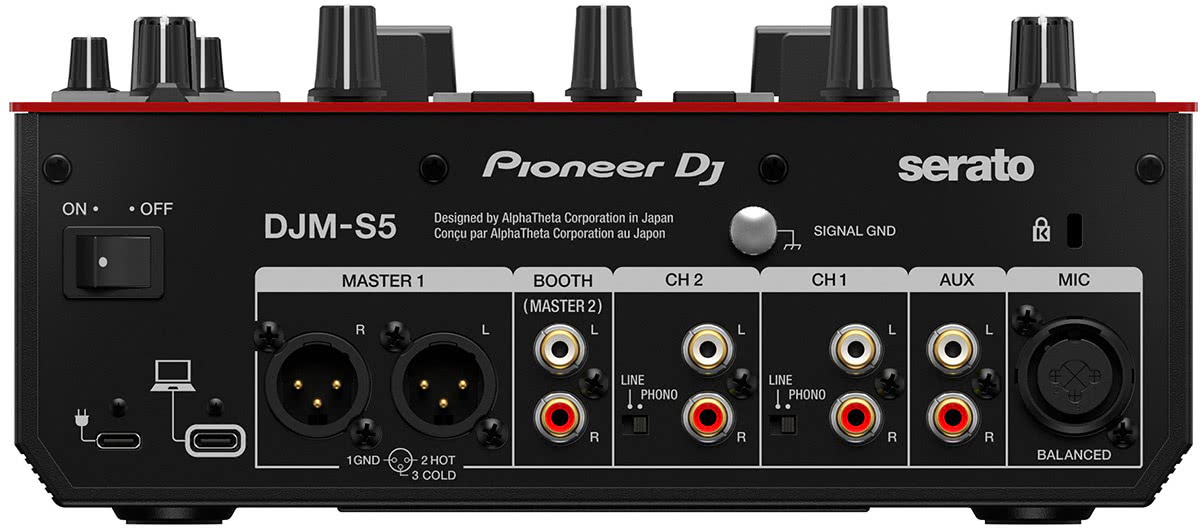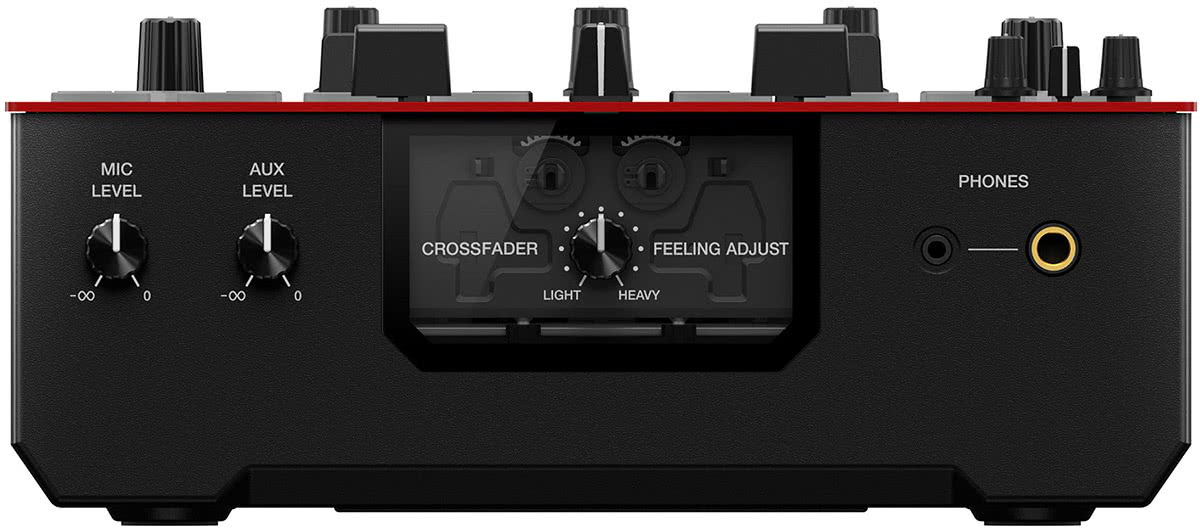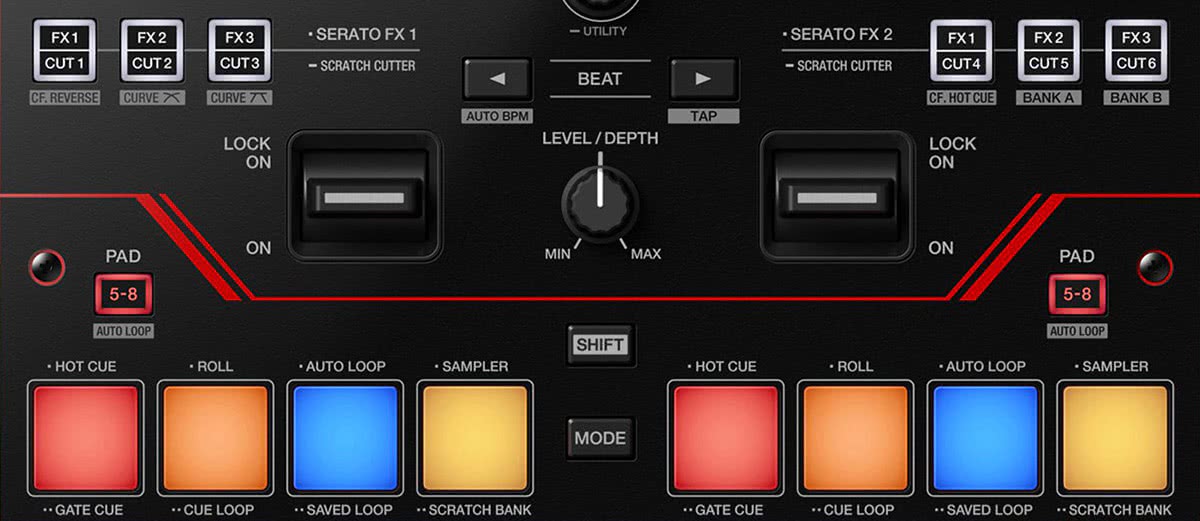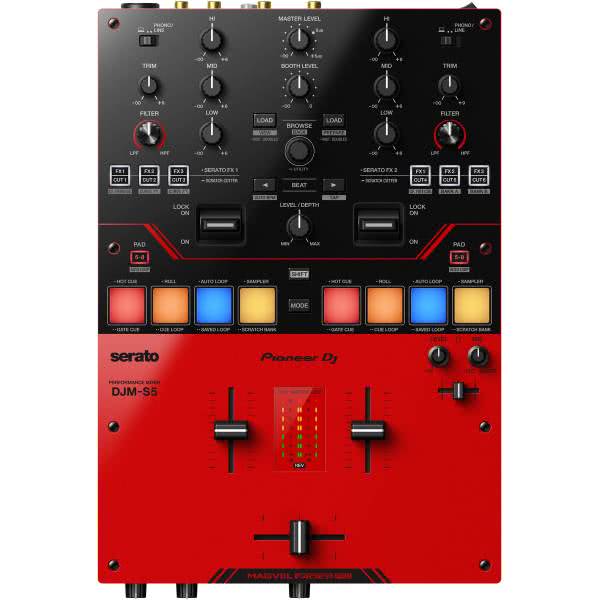The Pioneer DJ DJM-S5 is a mid-range scratch mixer designed for use with Serato DJ Pro, which it unlocks upon connection, forming the heart of a DVS setup.
It covers all the basics for scratch DJs looking for an affordable mixer with a professional feel.
The strength of the DJM-S5 lies in its professional build, including the same crossfader and effect paddles found in more expensive mixers. However, with only four performance pads on each side, which are also harder and "clickier" than those on larger devices, you'll have to accept some minor compromises.
First Impressions/Setup
Right out of the box, the DJM-S5 feels "professional" with its metal plate and eye-catching red finish (no other colors available). It features the same Magvel Fader Pro used in other Pioneer DJ scratch mixers, and a transparent plate has been added to the front of the mixer, allowing you to see the crossfader's operation, which is a nice design feature.
The layout will feel familiar to any DJ used to this type of mixer/controller, with the classic DJM-S9 layout for the EQs and filter of both channels, along with the exact same paddles for effects as on the DJM-S7.

On the back, there are RCA jacks for connecting turntables or line-level inputs (switchable), an aux input, and outputs for master and booth—nothing unusual here, except for the presence of two USB-C ports instead of other computer or power connections.
This is a pretty bold move that we like. The mixer can be powered from the computer via a cable if desired, or you can use the second USB-C port to connect the mixer to the power grid.
This means you can use the mixer in places without power as long as you have a laptop with you or you can power it using a power bank (though Pioneer DJ does not guarantee this, it worked well for us). However, there is no adapter in the box, so you'll need to organize your own power adapter (e.g., from your smartphone) to connect to the supplied cable.
Once you figure out the power setup, you can install Serato DJ Pro on your laptop (it's free; you just need to register on the Serato website) and connect the mixer to the computer to activate Serato.
And that's when you're ready to go...
In Use
The first thing you'll probably want to do is adjust the crossfader with the mechanical Feeling Adjust knob before familiarizing yourself with the software integration.

The only standalone effect is the filter, so when playing "regular" records or sources and using the mixer as a simple hardware mixer without software, this is the only effect you can work with. However, when you connect the mixer to a computer with Serato DJ, you can access all Serato effects and use the paddles and other effect controls.
The device does unlock Serato and Serato DVS, but be aware that Serato will try to sell you upgrades, so you'll have to pay extra for access to all 57 effects Serato offers. Additionally, you'll need to pay extra for Serato's Pitch 'n Time, which is required for high-quality pitch-shifting. However, the default effects are more than enough to create decent mixes and should be sufficient for many DJs.
As with many other scratch mixers from Pioneer and other manufacturers using the same principle, the effects can be intuitively controlled with the paddles, and depending on the direction you press them, you can easily turn effects on or "lock" them. Note that you always have access to only one effect on both decks.

The RGB performance pads will divide DJs: On the one hand, you can assign a different Serato performance function to each deck, which is not always possible on budget mixers or those of the first generation, and you have access to all Serato performance pad functions. On the other hand, the pads themselves are of the (presumably cheaper) "clicky" variety and not the smoother, more responsive pads found on more expensive mixers.
Additionally, there are only four pads per side, so you'll have to switch between banks using a 1-4/5-8 button to access the second set of four pads.
New Pad Features
However, the mixer does have two new pad features. The first is called "Scratch Cutter", which emulates six crossfader cut patterns when activated via the paddles. All you have to do then is move the turntable or jog wheel. As a performance tool, it's actually quite enjoyable, allowing you to emulate simple cut scratches to more complex transformer scratches (as developed by DJ Jazzy Jeff).
We found the operation to be more intuitive than the confusing "Jog Cutter" feature introduced with the Pioneer DJ DDJ-FLX6 controller.
The second new pad feature is "Crossfader Hot Cue," a variation of a function long found in DJ systems. It starts the deck playback when you move the crossfader away from the edge of the last selected cue point, creating a stutter effect. This is useful as it emulates tapping a hot cue button to stutter a track, something not possible with DVS systems otherwise.
And that's about it.
Crossfader curve and reverse are more button functions than hardware controls (as is the case with many features on this mixer), and overall, the mixer is defined as much by what it doesn't have as by what it does—no dedicated autoloop controls, only basic library controls, only Serato software effects (apart from the filters, there's nothing onboard)... But that's normal for a mixer targeting this market segment and price range.
The sound of the S5 is flawless and can be described as clear and present. You get exactly what is played through the input sources. The Pioneer DJ engineers have not made any mistakes here.
And one more little detail: the microphone channel is routed to the audio interface, meaning that if you're producing a livestream, your audience will hear any signal coming through the microphone even when the audio interface is streaming your livestream—something not often found in DJ equipment and a useful function in today's times.
Conclusion
The DJM-S5 is a solid scratch DJ mixer, looking good, equipped with high-quality components (if you can overlook the weaker performance pads), and it covers the essential needs of a DVS setup well.
The lack of onboard hardware effects is expected in this price range, but at least you have filters available when playing standalone. The USB-C power system is bold but a step in the right direction (in our opinion), and the new Serato features are at least an interesting addition.
Competition? The Numark Scratch probably comes closest—but it has even fewer features and is significantly cheaper. The biggest advantage over this mixer, in our view, is that the DJM-S5 has the ability to set different pad settings for each channel and full access to Serato's performance pad functions.
No, the DJM-S5 doesn't have the more advanced controls of the DJM-S7 and DJM-S11, but those are much more complex and elaborate mixers that, of course, come with a much higher price tag. For many DJs, especially beginners and hobbyists, what the DJM-S5 offers will be sufficient:
Nothing feels cheap, and as a performance instrument, even with only four pads per Serato deck, the DJM-S5 does its job well.
If you have old decks lying around that you want to bring into the digital world as part of a DVS system and you're looking for a simple mixer that works immediately with Serato DJ Pro and provides most of the essential features of much more expensive mixers, this mixer is a good choice. Just put Timecode vinyl on the turntable, and you're good to go.






